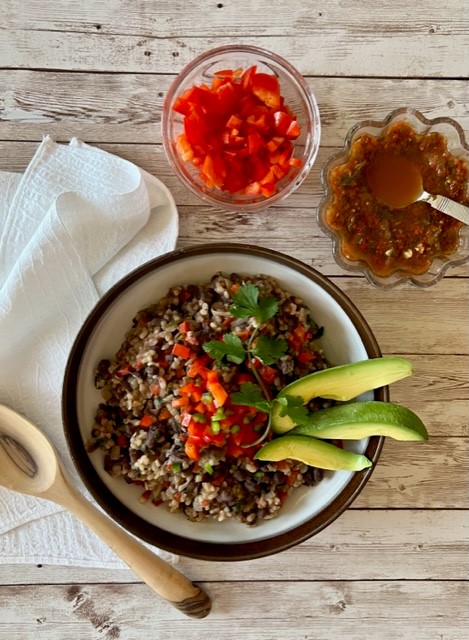Costa Rican-Style Black Beans & Rice

Can you eat your way to a longer life? Dan Buettner’s work over the past 20 or so years, studying and writing about Blue Zones™ (BZ), 5 places around the world with populations that enjoy especially long, healthy lives, suggests you can (1,2,3,4).
It’s not the only thing. Diet is one of the lifestyle and environmental factors that study of BZ suggests play a role in life expectancy.
Nothing new, Blue Zones™ work, which Beuttner has done with National Geographic and a variety of demographers, scientists, and researchers, has been going on some 20 years (2).
It started when Michel Poulain and Giovanni Mario Pes documented the extraordinary longevity of areas in Sardinia and marked them with blue marks on a map. They documented their findings in the Journal of Experimental Gerontology in 2004 and introduced the term Blue Zone (2,3,4). Then Dan Beuttner launched a program to identify other populations with extraordinary longevity around the world. Together they set up Blue Zones criteria and, as a National Geographic expedition, eventually certified 5 Blue Zone areas around the world where people not only live a long time, but they also have full, healthful lives:
Sardinia, Italy: Mountain villages here are home to the world’s longest-lived men.
Ikaria, Greece: An island “where people forget to die” and they have low rates of dementia.
Nicoya, Costa Rica: A peninsula where adults have the longest live expectancy in the Americas.
Okinawa, Japan: This South Pacific Island has the world’s highest percentage of centenarians, mostly women.
7th Day Adventists, Loma Linda California, USA: This group of people in Loma Linda live up to 10 years longer than other Americans.
Blue Zones studies have looked for lifestyle commonalities among the 5 populations and summarized them as the Power9® (5):
One is “Move Naturally.” Folks in BZ are not pumping iron or running a treadmill at the gym. They enjoy exercise through “activities of daily living” tending a garden, walking, or foraging for wild foods, for example.
Three involve connections with others and social networks: “Loved ones first” describes a focus on family, including elders, children, and a partner. “Belong” means that the majority of BZ people are part of a faith-based community. “Right Tribe” means that they are part of social circles that support a healthful lifestyle. Beuttner describes the Okinawan practice of forming “moais” a group of 5 people in the community who commit lifetime friendship and support.
Two involve “Outlook.” People in BZ live with a sense of “Purpose,” or “why I wake up in the morning.” “Downshift” means that BZ people enjoy ways to reduce stress each day via prayer, pausing to honor one’s ancestors, taking a nap, or, as in Sardinia, pausing for a glass of local Cannonau wine with friends and/or family.
Three are diet-related: “Plant Slant” one is a focus on plant foods. seldom eat meat, small portions maybe 5 times a month. The “4 pillars” of a BZ diet are described as grains, greens, nuts, and beans (3).
Another is the 80% Rule, eating until you’re 80% full. Before meals the BZ Okinawans say a Confucian mantra, hara hachi bu, to remind them to eat until they’re 80% full.
The third is “Wine at 5.” This is explained as “People in all BZ (except Adventists) drink alcohol moderately and regularly….1-2 glasses a day with friends and/or with food.” I think the benefits are more about the practice of gathering regularly to relax and socialize than the inclusion of alcohol. Not to be a buzz kill but recent studies indicate there’s no health benefit to consuming alcohol as described by the World Health Organization statement published this year (6,7).
Check out the BZ website and publications (Try your public library.) to learn more about the lives of these fascinating populations. Unfortunately, as these areas have become westernized, processed foods crowd out traditional mainstays, lifestyles change, and health and longevity has declined.
I tried several BZ recipes from the BZ website and cookbook as I prepared for a presentation I gave on Beyond Mediterranean – Traditional Eating Around the Globe which I’ll write more about in the future. They’re approachable recipes – short and easy- to-do yet beautifully reflect the traditional foodways.
Could something as simple as beans and rice be a longevity food? Beuttner says Gallo Pinto, a version of black beans and rice served for breakfast in Costa Rica’s Nicoya region, might be the world’s healthiest start to the day. It’s often served with nixtamalized corn tortillas, black coffee and chilero, a pickled vegetables and pepper condiment (3). And it also shows up at lunch and dinner, too.
I have fond memories of Gallo Pinto from my first trip to Costa Rica 30 years ago. It was the first time I ate beans and rice for breakfast.
In our protein-obsessed world some still believe animal protein is optimal. Note that rice and beans are complementary proteins because each provides the amino acids that the other lacks. Rice lacks the amino acid lysine and beans have it. Rice is high in the amino acid methionine, which beans lack. Pairing the two yields a complete amino acid profile needed by the body to build and repair tissue. It’s handy to have them in the same dish or meal but it’s not necessary as was once believed.
I laud the benefits of beans in these two blogs The Power of Pulses and Bean Cuisine: Black beans, which hail from central and south America, are rich in protein, dietary fiber, iron, magnesium, folate, and other nutrients. Plus, they have antioxidant anthocyanin pigments that give them their deep color (8).
Here’s a salute to simple foods rooted in tradition – like humble beans and rice-consumed in myriad ways around the world.
Costa Rican-Style Gallo Pinto
Serves 4
Adapted from: https://www.bluezones.com/recipe/panchitas-gallo-pinto/
Gallo Pinto is considered the national dish of Costa Rica, often eaten at every meal. I adapted this recipe from the Blue Zones recipe noted above and suggest using short grain brown rice instead of white. Spice it up with an habanero or other hot chili pepper and more spices, if you like. It’s fun served “bowl style” loaded with toppings. Or serve with corn tortillas, and a cooked egg, as they often do in Costa Rica.
½ yellow onion, chopped
1 tablespoon olive oil
1 red bell pepper, chopped, divided use
1 jalapeño, finely chopped, divided use
1 clove garlic, finely chopped
2 cups cooked or canned, rinsed and drained black beans
1 1/2 cups cooked brown rice
1 cup water
⅓ cup chopped cilantro
Salt and pepper, to taste
Optional Toppings:
Sliced avocado, lettuce, tomato, cilantro, hot sauce
DIRECTIONS
- Warm the oil in a large skillet over medium heat. Add the onion, half the bell pepper and half the jalapeno. Cook, stirring often, until onion softens. Add the garlic and cook until fragrant, about 20 seconds.
- Add the beans, rice, and water. Increase heat to medium-high and bring to a full simmer, stirring often, for about 2 minutes or until hot and most of the water evaporates (it can be a little saucy). Remove from heat. Stir in cilantro. Season with salt and pepper, to taste.
- Top with the remaining chopped bell pepper and jalapeno and serve warm with your favorite toppings.
References
2. Blue Zones Founder’s Statement. Founder’s Statement – Blue Zones
3. Foods to Live By. Dan Beuttner. National Geograpic Magazine. January 2020 105-121.
4. The Blue Zones Kitchen. 100 Recipes to Live By. Dan Buettner. National Geographic. 2019.
6. January 4, 2023. World Health Organization. No level of alcohol consumption is safe for our health (who.int)
7. Alcohol and health. American Institute for Cancer Research. https://www.aicr.org/cancer-prevention/food-facts/alcohol/
8. Black Beans. Joanna Foley, RD. Today’s Dietitian. Vol. 24, No. 6, P. 38 Black Beans – Today’s Dietitian Magazine (todaysdietitian.com)
© Lorelle Del Matto 2023
 About lorelle
About lorelle
This was very informative and inspirational, thanks Lorelle .
It’s reassuring that simple foods can nourish and sustain